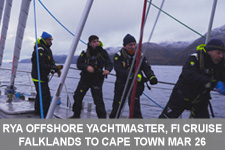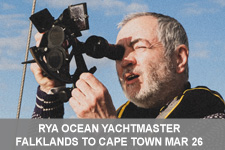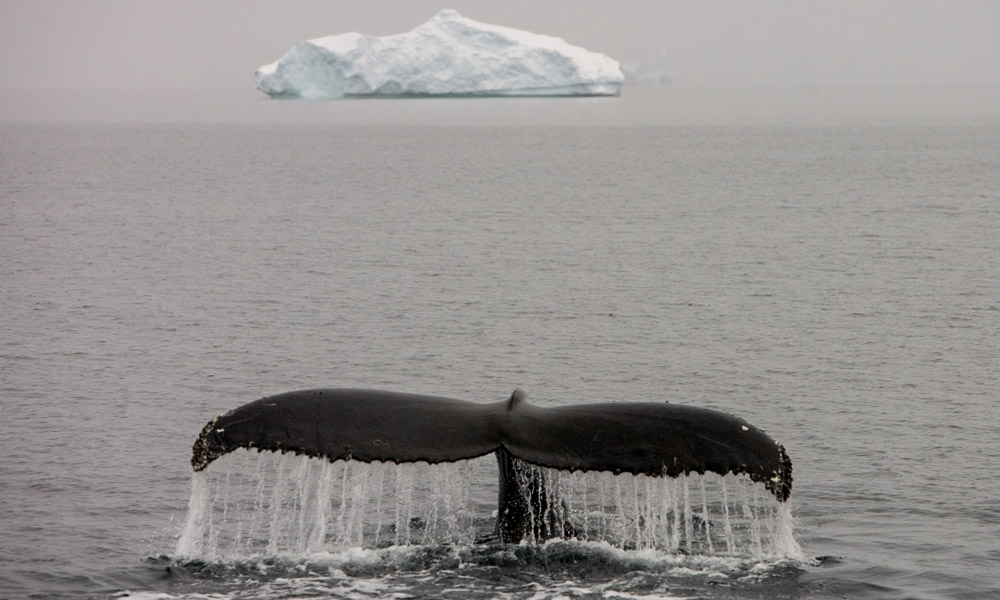Pelagic Australis in Antarctica - Dec 2017 - Mar 2018
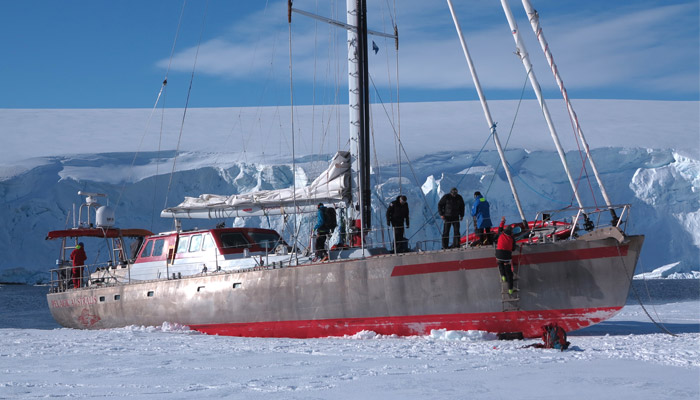
This cruise along the west side of the Antarctic
Peninsula will take in one of the most scenic and varied parts of the
continent. Pelagic Australis will be a mobile base camp and we will be
making several shore landings during the course of the time on the
Peninsula, but our style, unlike a cruise ship, is more time spent in fewer
areas with a flexible plan overall. See below for
detailed itinerary of the standard cruise. This season we are planning one special expedition led by Stephen Venables to climb, ski, sea kayak and watch wildlife, see prospectus here>> (plus another possible mountaineering focussed expedition for which detailed information will be issued on request). To find out more about the destination generally see destination Antarctica. To make a booking or for more information
please e-mail Skip Novak.
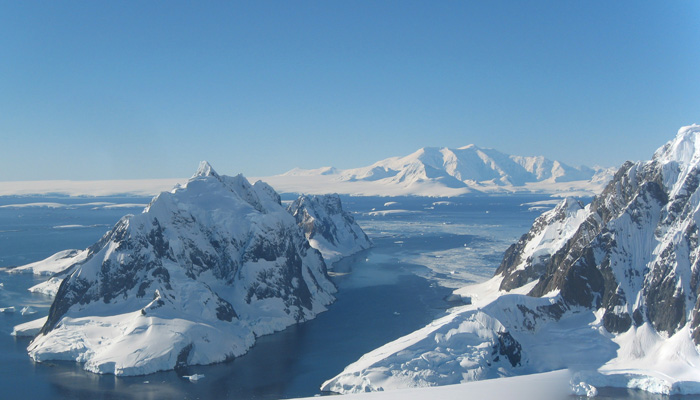
Mount Francais Antarctica from Mount Scott
DATES
Trip1 - 1 Dec - 21 Dec 2017 - Antarctica Ice with Everything
Trip2 - 4th Jan - 1 Feb 2018 – Antarctica - Stephen Venables led expedition to climb, ski, sea kayak and watch wildlife. Click here for Stephen's detailed prospectus for this trip>>
Trip 3 -10 Feb - 3 Mar 2018 – Antarctica Ice with Everything.
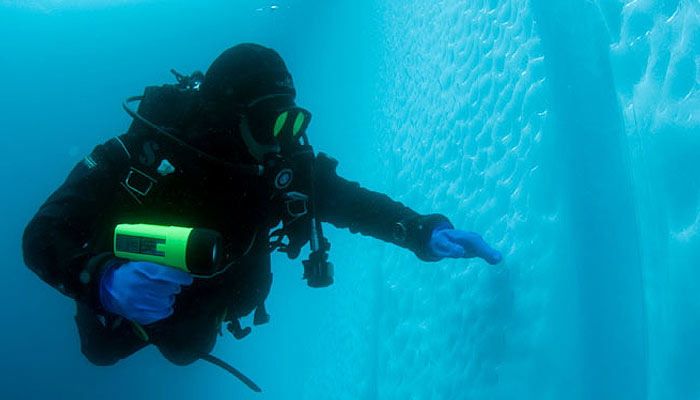
Antarctica dive option
LOGISTICS
The voyage would begin and end in Puerto Williams Chile which is on the
south side of the Beagle Channel. The guests would fly into Puerto Williams
and come immediately on board with the beginning of the crossing of the
Drake Passage (weather permitting) the following day. Considering the
traverse there and back, it is envisaged that the group would have 12 days
on the Peninsula for shore landings and exploring.
HOW TO GET TO PUERTO WILLIAMS
This may confound your travel agent. Puerto Williams is serviced once daily
by air by DAP from Punta Arenas on the Straits of Magellan, that is in turn
serviced three times daily by Lan Chile from Santiago.
The plane is usually a Dash 7 and you land on a runway right next to the
Beagle Channel. We will be there to meet you on arrival. The boat is a five
minute car ride away.
For flight information in Tierra Del Fuego in particular getting to and from Puerto Williams and Punta Arenas contact:
Catalina Navarrete B. ANTARCTIC AIRWAYS
Direct phone: 56-61-2616124
Mobile: +569 99392684 - +569 93461487
Address: O'Higgins 891 - Punta Arenas - Chile
E-mail: catalina@dap.cl - agencia@dap.cl
Website: www.dap.cl
ACCOMMODATION PUERTO WILLIAMS
For clients spending a night in Puerto Williams either before or after the cruise, we recommend the following:
Lakutaia
+56 61621721
ventas@lakutaia.cl
www.lakutaia.cl
This is the only luxury hotel in Puerto Williams and highly recommended for
a soft start to the trip.
Hostel Pusaki
+56 61621116
fax +56 61621224
pattypusaki@yahoo.es
COST
Per person 12,500 GBP per person which is all inclusive of food and drink once on board. A maximum of eight guests is envisaged.
This cost includes the use of Sail Racing sailing foul weather gear, all personal safety equipment for sailing (lifejacket, harness) and the use of the Inmarsat communications equipment. (note: satime is billed separately as used).
ALCOHOL CONSUMPTION POLICY ONBOARD
Pelagic Australis is run as a 'dry ship' when at sea and possibly at some anchorages when there is a real possibility of having to 'up anchor' and move off. This is at the Skipper's discretion. In port reasonable amounts of alcohol can be consumed but excessive alcohol consumption that leads to situations putting people at risk, or where the harmony of life on board is disturbed to an extent that other guests are made uncomfortable will not be tolerated. If this situation arises, the Skipper reserves the right to return to port and to disembark any Charterer at an intermediary port, or disembark the entire group in a group charter if necessary.
An account of one of our "Sailing to Climb" trips to Antractica in January 2016 40 minute video
PROPOSED ITINERARY
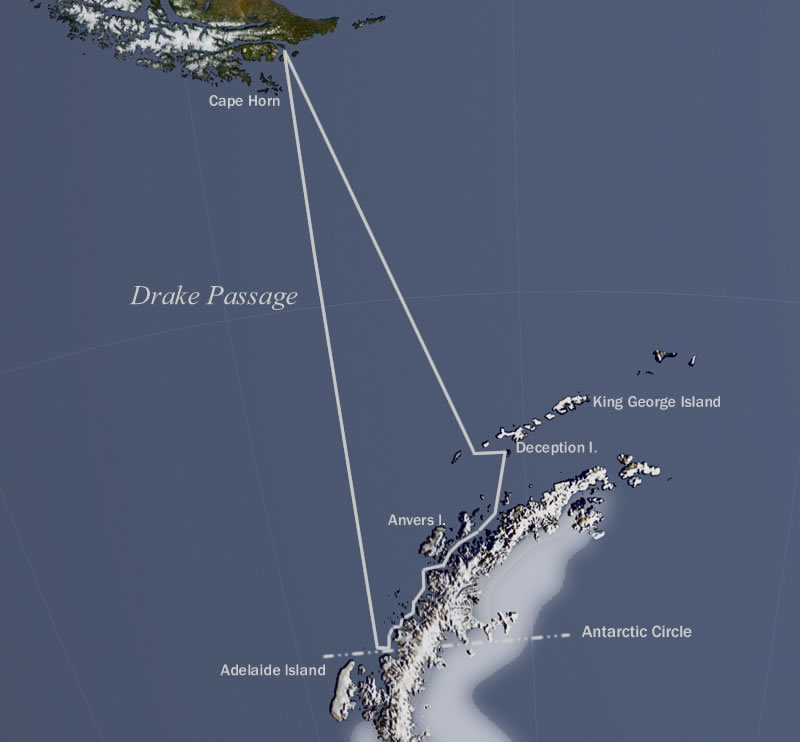
It must be understood that the itinerary outlined below can only be a rough guide to what we will see and do while on the Antarctic Peninsula. Every cruise will vary due to weather and ice conditions, making it impossible (nor desirable) to fix a rigid plan.

DAY 1
Board Pelagic Australis in Puerto Williams Chile. The afternoon is spent stowing personal gear, familiarizing the team with the vessel and having a safety briefing. On a trip coinciding with New Years Eve this can be spent tied up alongside the ‘Micalvi,’ - a ruined Chilean naval vessel cum Yacht Club.
DAY 2
Clear out of Puerto Williams and head east through the Beagle Channel and
turn south through the Cape Horn archipelago. Weather permitting, we will
sail directly across the Drake Passage for the Peninsula. On the other hand,
if the forecast is for strong headwinds, or risk of storm, we will shelter
in any number of three anchorages within the archipelago. If we are storm
bound for a day or two while the system moves through, there are
opportunities for long walks ashore on the rugged terrain of Tierra del
Fuego.
DAYS 2-5
Crossing the Drake Passage to first shelter on Deception Island should take no more than 60 hours. It is emphasized again that if storm winds are forecasted, a day or two waiting in the Cape Horn archipelago will be necessary until a safe and comfortable crossing can be made.
Crossing the Drake in 45 knots of breeze
DAYS 4-5
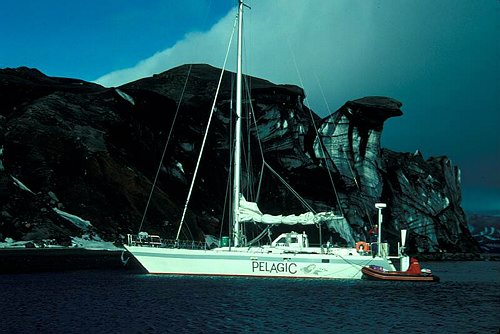 Arrive on Deception Island in the South Shetland archipelago. This is a semi
active volcanic island and we enter the lagoon which is the flooded
caldera. The landscape is unique in the Antarctic region as the
island’s shape is a combination of volcanic ash and layers of ice. One night
and day will be spent here rigging the boat for inshore sailing, briefing
the team on the Antarctic guidelines with respect to the wildlife and taking
any number of walks ashore which can include a visit to Whalers Bay, the
site of the first commercial whaling operation in the region. On the day of
departure, sea conditions permitting, we will try to land on the southeast
corner of Deception where there is one of the largest Chinstrap Penguin
colonies in the Antarctic.
Arrive on Deception Island in the South Shetland archipelago. This is a semi
active volcanic island and we enter the lagoon which is the flooded
caldera. The landscape is unique in the Antarctic region as the
island’s shape is a combination of volcanic ash and layers of ice. One night
and day will be spent here rigging the boat for inshore sailing, briefing
the team on the Antarctic guidelines with respect to the wildlife and taking
any number of walks ashore which can include a visit to Whalers Bay, the
site of the first commercial whaling operation in the region. On the day of
departure, sea conditions permitting, we will try to land on the southeast
corner of Deception where there is one of the largest Chinstrap Penguin
colonies in the Antarctic.
DAY 5
Sail south for the Gerlache Straits. This can be done overnight (in relative daylight) as the majority of the passage is offshore through the southern portion of the Bransfield Straits. From the northern section of the Gerlache Straits, we would navigate in between Anvers Island and Weincke Island – the Neumayer Channel - and then continue south towards the Penola Straits.

From here on South, Humpback Whales will be in abundance,
so we can divert at any time to try and get close to them, which involves
turning off the engine and drifting, hoping they come to us. Leopard Seals
can also be approached as they ride the ice floes feeding off the penguin
population.
DAY 6
Early morning sail through the Lemaire Channel which is a narrow, ice filled passage fringed between the high mountains of Booth Island and the mainland. This is considered to be the most scenic stretch of water on the Peninsula and hence its nickname, “Kodak Valley!”
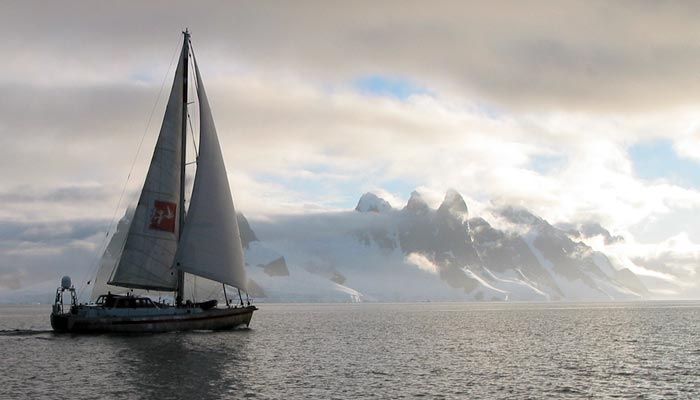
We would spend the day in the Penola Straits, with a possible temporary
anchorage off Hovgaard Island. This and the nearby Pleneau Island are good
places for a walk ashore where a small colony of Elephant Seals reside. The
night would be spent anchored off Booth Island with stern lines to the shore
on either side of an isthmus depending on which way the wind was blowing.
DAY 7
In the middle of Penola Straits lies Yalour Island which is one of the most attractive Adelie Penguin colonies on the Peninsula. On a sunny day, the views across to Mt. Shackleton and the peninsula plateau beyond are spectacular. In good weather we would anchor off here for the morning and go ashore.
The afternoon and night would be spent only a few miles away at the
Ukrainian scientific station Vernadsky. This was formerly the British
Antarctic Survey base Faraday, where the "Ozone Hole" was discovered with the
Dobson spectrameter which is still in use today. We normally get a good
welcome and a tour from the base commander. The anchorage is very protected
and we moor to the shore in a narrow backwater in the small archipelago of
the Argentine Islands. This is also the most secure of storm anchorages.
This is probably the best example of one of the old Peninsula bases that is
still functioning.
DAYS 8-11
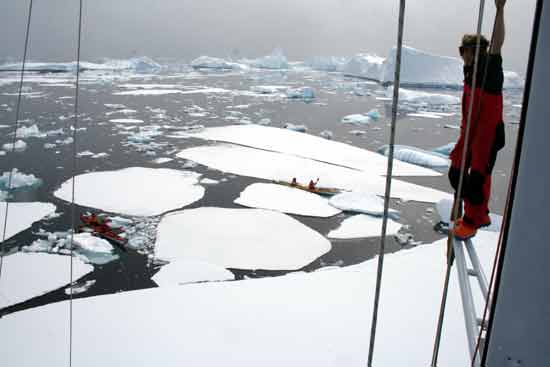 Three days would be spent probing south into the Grandidier Channel and
possibly into Crystal Sound. Since last year’s sea ice is very
unpredictable, it is never sure how far we can get on the inside passage, so
we may have to backtrack and go on the outside via the Pitt Islands where we
have good shelter. On the outside of the island chain the big icebergs are
usually stacked up touching the bottom and breaking up. If there is a swell
running it is dramatic to see them heaving up and down and not uncommon to
see quite a few capsize.
Three days would be spent probing south into the Grandidier Channel and
possibly into Crystal Sound. Since last year’s sea ice is very
unpredictable, it is never sure how far we can get on the inside passage, so
we may have to backtrack and go on the outside via the Pitt Islands where we
have good shelter. On the outside of the island chain the big icebergs are
usually stacked up touching the bottom and breaking up. If there is a swell
running it is dramatic to see them heaving up and down and not uncommon to
see quite a few capsize.
The culmination of the voyage and the goal on this stretch would be to reach the level of the Antarctic Circle and land on the mainland. If we can make it through the inside we would shelter near Prospect Point at the Fish Islands. Prospect Point is the site of an old British Antarctic Survey base that was abandoned in the 50’s and is soon to be removed. An interesting place if it is still standing!
This will be a highly variable (and therefore the most interesting part of
the voyage for some people!) part or the cruise, as the landscape here is
open and stunning, but on the other hand very challenging as the good
shelters for the vessel are few and far between. This is where we ‘suck it
and see’ for a better turn of phrase.
DAYS 12,13,14
Aggregate lost time assumed due to unnavigable conditions. We would be storm
bound somewhere!
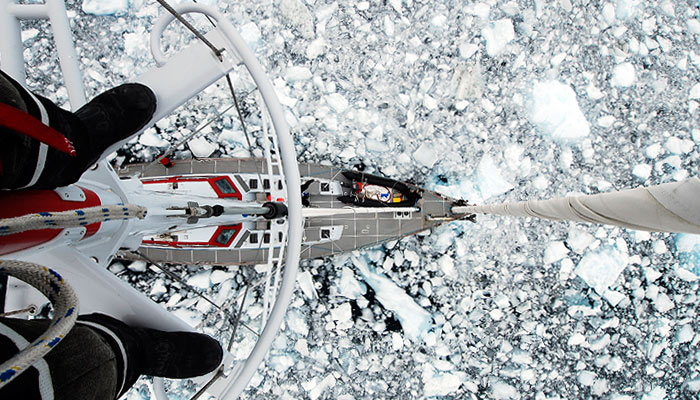
DAY 15
Working our way back up north through the Penola and Lemaire Channels we would anchor and put lines ashore to Weincke Island near Port Lockroy. This has become the de facto visitor center for the cruise ship trade, but it is always worth a visit. Formerly a British Antarctic Survey base and recently renovated as an information center, they provide the service of a British Post Office selling stamps, post cards, information sheets, maps, etc. The base, manned in summer only, has been declared a Site of Historic Interest within the framework of the Antarctic Treaty System. The base was originally built on a Gentoo Penguin colony and today the humans are still very much the guests.
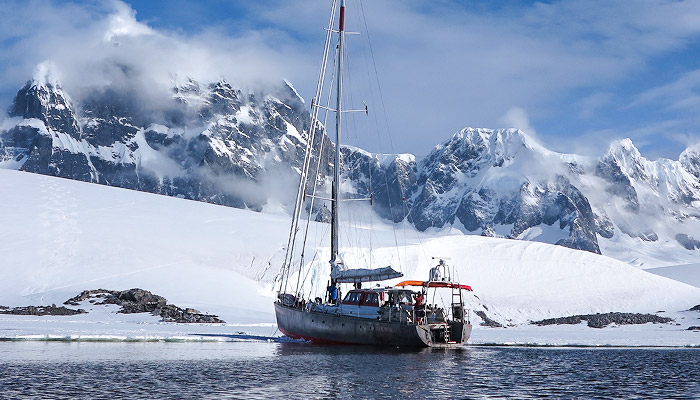
DAY 16
Going south about Weincke Island back into the Gerlache we would steam for a
few hours into Paradise Harbour, again spotting Humpback Whales along the
way. The night could be spent at Cuverville Island (bird and seal
populations) to the north or within the Melchior Archipelago between Anvers
and Brabant Islands.
DAY 17
 Eventually, the Melchoir Islands are the best place to jump off from for the
return passage across the Drake. By Day 16, we should be watching the
weather closely for an opportunity to cross. The downside is an early
departure, but any spare days can be spent near Cape Horn with a visit to
Horn Island possible. The risk of a late departure is missing a favorable
pattern and still being there on Day 20! When needed, we are using a weather
router in America so we can predict the situation for about five days in
advance.
Eventually, the Melchoir Islands are the best place to jump off from for the
return passage across the Drake. By Day 16, we should be watching the
weather closely for an opportunity to cross. The downside is an early
departure, but any spare days can be spent near Cape Horn with a visit to
Horn Island possible. The risk of a late departure is missing a favorable
pattern and still being there on Day 20! When needed, we are using a weather
router in America so we can predict the situation for about five days in
advance.
DAYS 18-20
Recrossing the Drake Passage and/or spare days at Cape Horn.
DAY 21
Puerto Williams, last night on board.
DAY 22
The guests would fly back to Punta Arenas and connect to Santiago.
EQUIPMENT LIST
Equipment List 1 -
For expedition cruises to Antarctica, South Georgia, Tierra del Fuego and
all Arctic destinations.
Please
e-mail Skip Novak for more information or to make a booking.
Ski randonne Antarctica video
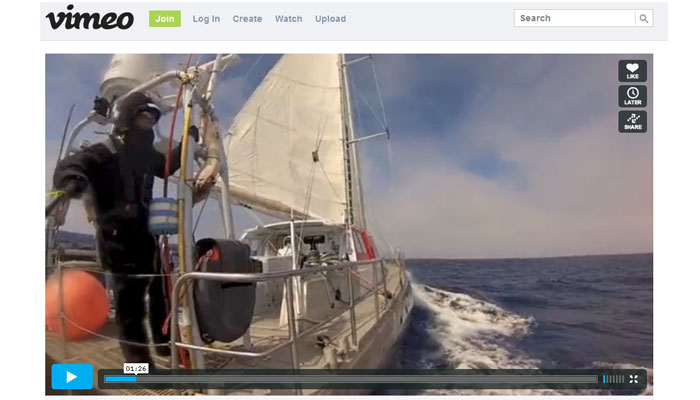
Click image to watch 20 minute video of our 2013 sailing to climb expedition
to Antarctica


